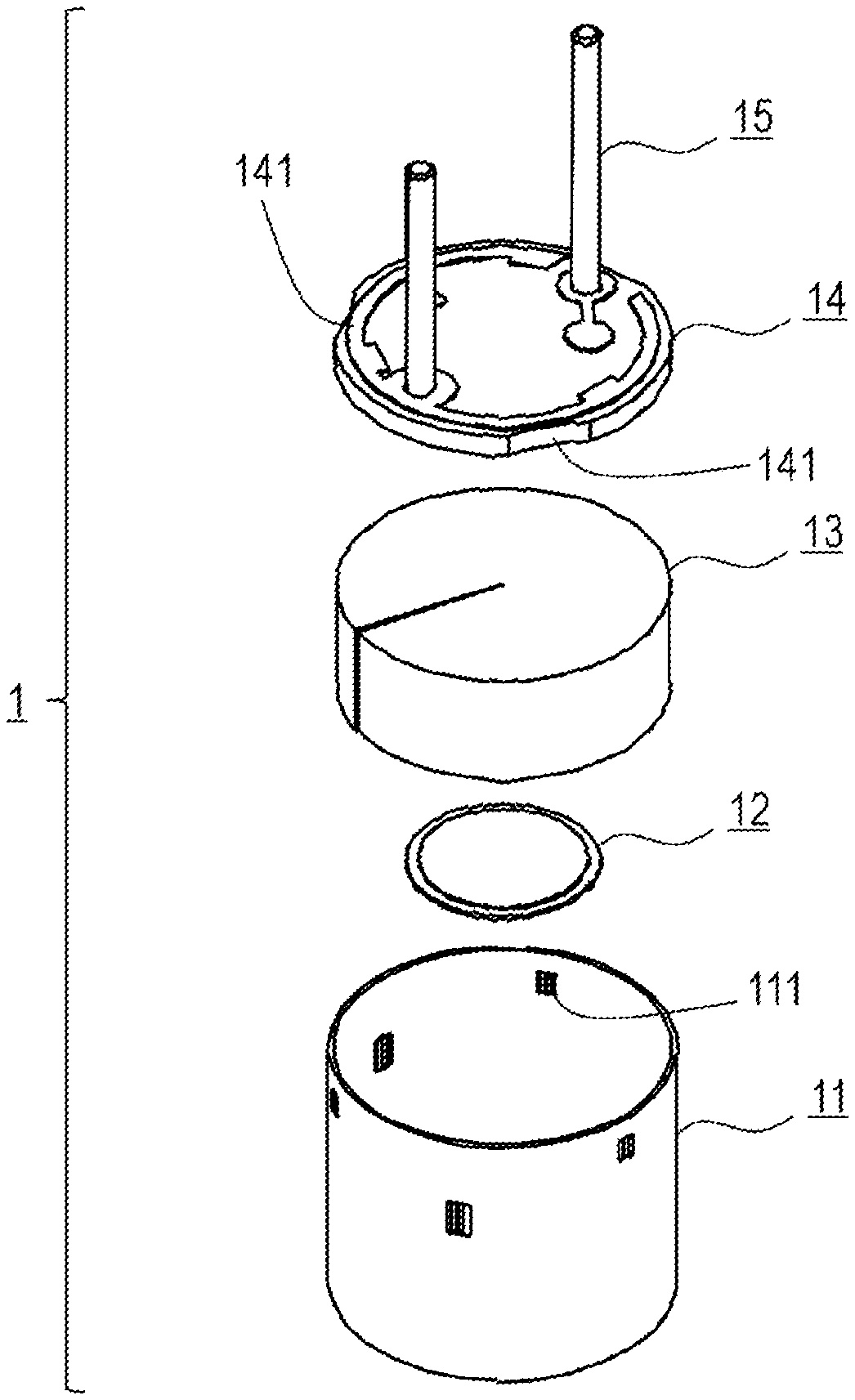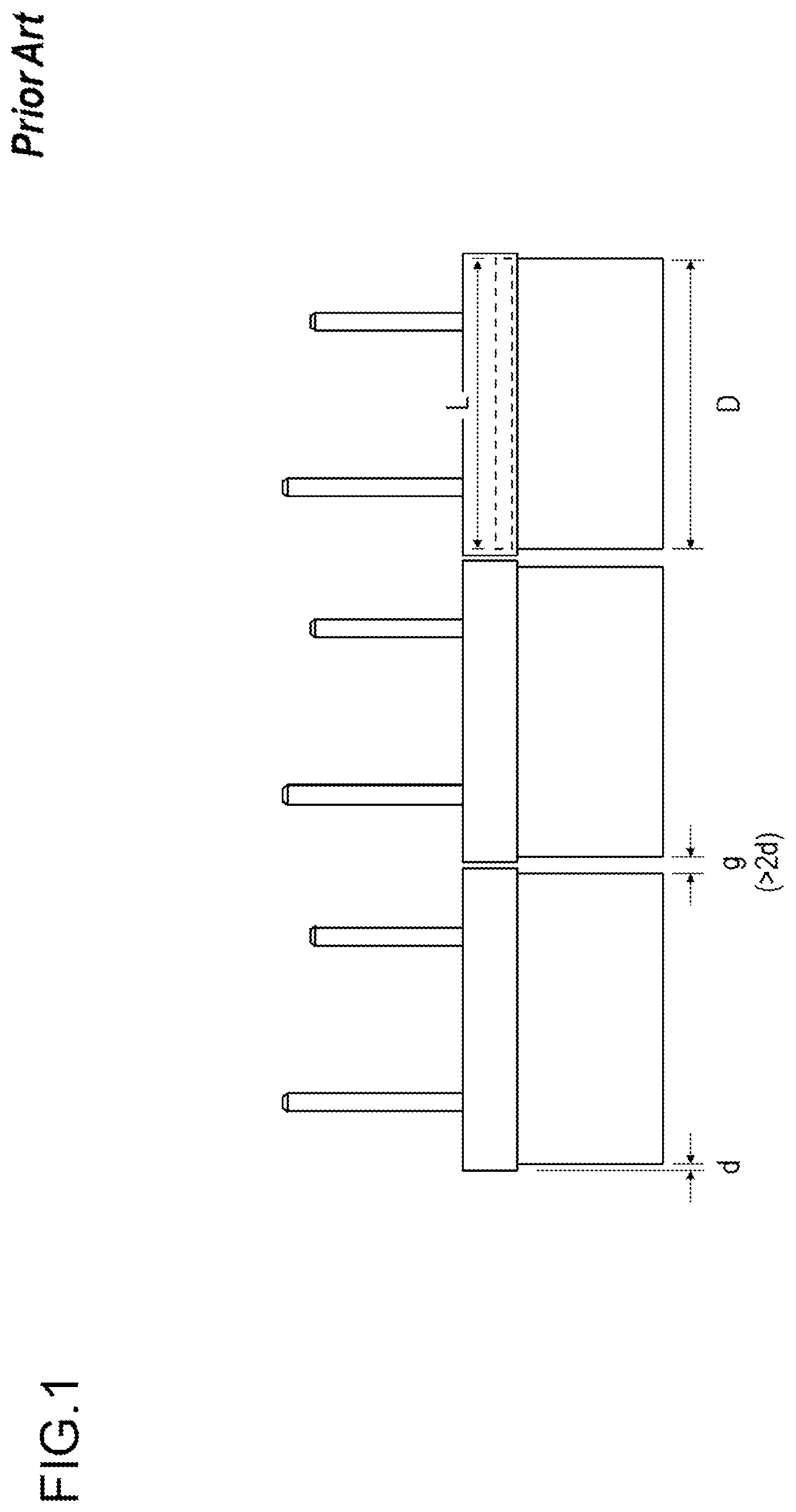Ultrasonic Speaker
TANAKA; Akihiro ; et al.
U.S. patent application number 17/494092 was filed with the patent office on 2022-04-14 for ultrasonic speaker. This patent application is currently assigned to HOSIDEN CORPORATION. The applicant listed for this patent is HOSIDEN CORPORATION. Invention is credited to Ryo INOUE, Akihiro TANAKA.
| Application Number | 20220116699 17/494092 |
| Document ID | / |
| Family ID | 1000005942085 |
| Filed Date | 2022-04-14 |






| United States Patent Application | 20220116699 |
| Kind Code | A1 |
| TANAKA; Akihiro ; et al. | April 14, 2022 |
ULTRASONIC SPEAKER
Abstract
An ultrasonic speaker comprises a case that has an opened top surface and includes a plurality of protrusions protruding inward on an inner side surface of the case, a piezoelectric element fixed to a bottom surface in the case, and a substrate that is inserted in the case and placed on upper surfaces of the plurality of protrusions.
| Inventors: | TANAKA; Akihiro; (Osaka, JP) ; INOUE; Ryo; (Osaka, JP) | ||||||||||
| Applicant: |
|
||||||||||
|---|---|---|---|---|---|---|---|---|---|---|---|
| Assignee: | HOSIDEN CORPORATION Osaka JP |
||||||||||
| Family ID: | 1000005942085 | ||||||||||
| Appl. No.: | 17/494092 | ||||||||||
| Filed: | October 5, 2021 |
| Current U.S. Class: | 1/1 |
| Current CPC Class: | H04R 1/021 20130101; H04R 2217/03 20130101; H04R 1/323 20130101 |
| International Class: | H04R 1/32 20060101 H04R001/32; H04R 1/02 20060101 H04R001/02 |
Foreign Application Data
| Date | Code | Application Number |
|---|---|---|
| Oct 14, 2020 | JP | 2020-173050 |
Claims
1. An ultrasonic speaker comprising: a case that has an opened top surface and includes a plurality of protrusions protruding inward on an inner side surface of the case; a piezoelectric element fixed to a bottom surface in the case; and a substrate that is inserted in the case and placed on upper surfaces of the plurality of protrusions.
2. The ultrasonic speaker according to claim 1, wherein the protrusions are arranged on both upper and lower stages of the inner side surface of the case which correspond to two types of reference depths on the inner side surface of the case, and the substrate includes notches at positions where the substrate passes through the protrusions on the upper stage, and is placed on the upper surfaces of the protrusions on the lower stage.
3. The ultrasonic speaker according to claim 2, wherein the protrusions on the upper and lower stages are arranged at positions where the substrate is held between the protrusions on the upper and lower stages by passing the substrate through the protrusions on the upper stage and then rotating the substrate by a predetermined angle with a vertical direction set as a rotation axis.
Description
TECHNICAL FIELD
[0001] The present invention relates to an ultrasonic speaker suitable for a parametric speaker.
BACKGROUND ART
[0002] For example, Japanese Registered Patent No. 6707242 and the like disclose related art examples of an array type parametric speaker using ultrasonic speakers.
[0003] Some of the related art examples have adopted a structure in which a case is provided with a step so that the inner diameter of the bottom surface of the case is smaller than the inner diameter of the top surface (opening portion) of the case, and a substrate is placed on the top surface of the step.
[0004] In the case where this structure is adopted, even when ultrasonic speakers are arranged to be spread all over as densely as possible as shown in FIG. 1, a gap g occurs between adjacent ultrasonic speakers, and the gap g is equal to a value larger than the double (2d) of the step d (g>2d). As a result, the size (outer diameter D) of the bottom surface of the case becomes smaller than the size (outer diameter L) of the substrate, which has caused a problem that an effective vibration area cannot be gained.
SUMMARY OF THE INVENTION
[0005] Therefore, the present invention has an object to provide an ultrasonic speaker capable of increasing an effective vibration area as compared with the size of a substrate and improving the characteristics of a parametric speaker.
[0006] An ultrasonic speaker of the present invention comprises a case that has an opened top surface and includes a plurality of protrusions protruding inward on an inner side surface of the case, a piezoelectric element fixed to a bottom surface in the case, and a substrate that is inserted in the case and placed on upper surfaces of the plurality of protrusions.
Effects of the Invention
[0007] According to the ultrasonic speaker of the present invention, the effective vibration area can be increased as compared with the size of the substrate, and the characteristics of the parametric speaker can be improved.
BRIEF DESCRIPTION OF THE DRAWINGS
[0008] FIG. 1 is a diagram showing an example of a conventional ultrasonic speaker;
[0009] FIG. 2 is a perspective view of an ultrasonic speaker of a first embodiment;
[0010] FIG. 3 is an exploded perspective view of the ultrasonic speaker of the first embodiment;
[0011] FIG. 4 is a plan view of the ultrasonic speaker of the first embodiment; and
[0012] FIG. 5 is a cross-sectional view of the ultrasonic speaker of the first embodiment.
DETAILED DESCRIPTION
[0013] Hereinafter, an embodiment of the present invention will be described in detail. Components having the same functions are designated by the same reference numerals, and duplicative description thereon will be omitted.
First Embodiment
[0014] Hereinafter, the structure of an ultrasonic speaker of a first embodiment will be described with reference to FIGS. 2 to 5. As shown in FIG. 3, an ultrasonic speaker 1 of the present embodiment comprises a case 11 having a cylindrical shape that has an opened top surface and includes a plurality of protrusions 111 protruding inward on an inner side surface of the case, a disc-shaped piezoelectric element 12 fixed to a bottom surface in the case 11, a disc-shaped sponge piece 13 that is accommodated in the case 11 and arranged so as to cover the piezoelectric element 12, a disc-shaped substrate 14 that is inserted in the case 11 and placed on upper surfaces of the plurality of protrusions 111, two pins 15 that are connected to the substrate 14 and extend upward, and a lead wire (not shown) for connecting the pins 15 and the piezoelectric element 12. The substrate 14 is, for example, a PCB. Note that the top surface (opened surface) of the case 11 is hermetically sealed with a sealing material (not shown). The sealing material may be, for example, a silicon-based material.
[0015] As shown in the cross-sectional view of FIG. 5 (a cutting line is shown in FIG. 4), the protrusions 111 are arranged on both upper and lower stages of the inner side surface of the case 11, which correspond to two types of reference depths on the inner side surface of the case 11. As shown in FIG. 3, the substrate 14 includes notches 141 at positions where the substrate 14 passes through the protrusions 111 on the upper stage, and is placed on the upper surfaces of the protrusions 111 on the lower stage as shown in FIG. 5.
[0016] It is preferable to arrange the protrusions 111 on the upper and lower stages at positions where the substrate 14 is held between the protrusions 111 on the upper and lower stages by inserting the substrate 14 into the case 11 while the notches 141 are aligned with the protrusions 111 on the upper stage to allow the substrate 14 to pass through the protrusions 111 on the upper stage, and then rotating the substrate 14 by a predetermined angle with a vertical direction set as a rotation axis (see FIG. 5).
[0017] For example, a total of three protrusions 111 on the upper stage are provided to be arranged at angular intervals of 120.degree., and a total of three protrusions 111 on the lower stage are provided to be likewise arranged at angular intervals of 120.degree. and further rotationally shifted by 60.degree. from the three protrusions 111 on the upper stage respectively. The substrate 14 has a total of three notches 141 arranged at angular intervals of 120.degree.. The substrate 14 is passed through the protrusions 111 on the upper stage, and then rotated by about 30.degree. with the vertical direction set as the rotation axis, whereby the substrate 14 can be fixed. Note that the distance in the vertical direction between the lower surface of each protrusion 111 on the upper stage and the upper surface of each protrusion 111 on the lower stage is substantially equal to the thickness of the substrate 14.
[0018] The ultrasonic speaker 1 of the present embodiment is configured so that the protrusions 111 protruding inward are provided in the case 11, and the substrate 14 is placed on the upper surfaces of the protrusions 111. Therefore, the inner diameter of the bottom surface of the case can be made equal to the inner diameter of the top surface of the case, so that the gap g occurring between adjacent ultrasonic speakers can be almost eliminated (the adjacent pitch can be reduced), the effective vibration area can be increased, and the characteristics of the parametric speaker can be improved.
[0019] According to the ultrasonic speaker 1 of the present embodiment, the protrusions 111 on the upper and lower stages are arranged at positions where the substrate 14 is held between the protrusions 111 on the upper and lower stages by passing the substrate 14 through the protrusions 111 on the upper stage and then rotating the substrate 14 by a predetermined angle with the vertical direction set as the rotation axis. Therefore, the substrate 14 can be fixed by interposing the substrate 14 between the protrusions 111 on the upper and lower stages, and a step of soldering lead wires to the substrate 14 can be easily performed (in the related art, a substrate is simply placed on the pedestal of a case, so that when a piezoelectric element is soldered and connected to the substrate with lead wires, it is necessary to hold the substrate so that the substrate does not move). Further, this structure also contributes to holding the substrate 14 horizontally. For example, even when the upper surface of the substrate 14 is filled with a sealing material (silicon) or the like in order to improve the characteristics, it is possible to prevent the substrate 14 from tilting due to the weight of the sealing material (silicon).
* * * * *
D00000

D00001

D00002

D00003

D00004

D00005

XML
uspto.report is an independent third-party trademark research tool that is not affiliated, endorsed, or sponsored by the United States Patent and Trademark Office (USPTO) or any other governmental organization. The information provided by uspto.report is based on publicly available data at the time of writing and is intended for informational purposes only.
While we strive to provide accurate and up-to-date information, we do not guarantee the accuracy, completeness, reliability, or suitability of the information displayed on this site. The use of this site is at your own risk. Any reliance you place on such information is therefore strictly at your own risk.
All official trademark data, including owner information, should be verified by visiting the official USPTO website at www.uspto.gov. This site is not intended to replace professional legal advice and should not be used as a substitute for consulting with a legal professional who is knowledgeable about trademark law.